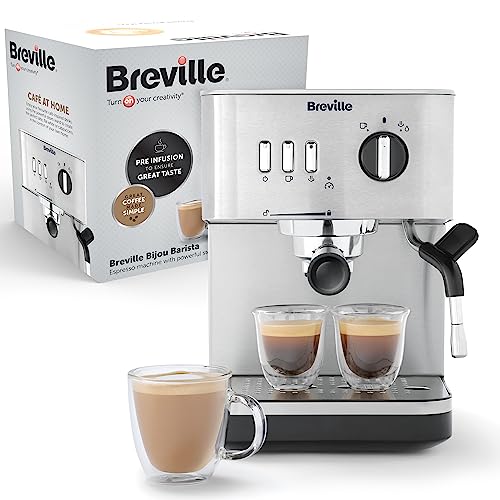Coffee and Espresso Machines
Espresso machines use pressure to force water through finely ground and tamped coffee beans. They produce a rich and tasty brew.
Good Housekeeping Institute experts recommend models that use a minimum of 9 bars for a perfect extraction. Beware of companies who claim they use more pressure than is needed.

Types
The espresso machine (also called a coffee maker and Espresso maker) makes coffee that is more concentrated, and of better quality, and more expensive than your typical coffee drinks at the cafe. It works with an average of nine bars of pressure. These machines are equipped with many features, including temperature and brew-strength control with programmable brewing as well as multiple sizes of drinks. They can also have steam wands for manual or automatic use to create an latte with a texturized milk. There are three kinds of latte art of semi-automatic, super-automatic, and automatic. coffeee.uk comes with its own level of supervision and control.
Semi-automatic espresso machines are the most popular in specialty coffee shops. Semi-automatic espresso machines offer baristas full control of the brewing process, however they are not as user friendly as fully automatic or automated machines. It is still necessary to grind beans, fill and tamp the portafilter, and adjust the extraction time to ensure the highest espresso shot.
Automatic machines come with built-in mills that measure and grind your grounds. They automatically pour the correct amount of water to make the espresso, and they often have a programmable beverage size function. They were the most commonly used espresso machine type in our lab tests and they offer a good balance of consistency and human control.
Functions
There will be a need for a reservoir that can hold the water that you use to make coffee, irrespective of whether you opt for a steam-driven or pump-driven machine. You'll also have a heating component that warms the water to produce the pressure needed to extract the coffee from the grounds.
When the brew button is pressed when the button is pressed, the valve that lets water into the brew chamber is closed to ensure that only hot water under high pressure can pass through the portafilter before it is absorbed into the ground coffee. It takes around 25 minutes for the water to be brewed into espresso.
The hot-water tubing, also referred to as the insulated tube extends from the reservoir to the spout at top of your machine. The heating element of resistance heats the water as it moves through the warming plate made of metal and the aluminum tube.
When the spout is turned on, place your cup under the spout in order to capture the espresso as it is pushed through the portafilter into your cup. The coffee maker also has steam wands that can be used to heat up and froth milk for coffee-based drinks such as cappuccino and latte.
Automated machines take the guesswork involved in the process of brewing. They are simple to operate, programmable and can measure and grind beans as well as to tamp down. They generally be the most efficient overall in our Lab tests since they are very user-friendly and don't require a lot of user-friendly skills.
Materials
Inside an espresso machine, you'll find a veritable maze of copper tubes and stainless steel boilers. There's also an intelligent firmware. Although they might appear to be complicated however their main purpose is to force hot water into finely ground coffee.
When you are buying an espresso machine be sure to take into account the size and space requirements, as well as the drink options, energy saving options, and brewing precision. Look for a button that can be used to activate the steam wand. This is used for creating lattes and frothing milk. A gauge for pressure on the front of the machine lets you know the boiler's and pump's operational pressure. Find a coffee maker that has two needles, so that you can see both the maximum and minimum pressure.
If you want to make more than espresso, pick a machine that offers different sizes of brew, including the ristretto. You can also find models with an adjustable milk hopper to allow effortless, easy frothing and the ability to switch between different kinds of milk. Pick a model that comes with an integrated softener in case you have hard water to prevent mineral accumulation and keep your espresso fresh.
Some manufacturers use PID (proportional, integral, digital) thermostat to maintain the temperature of espresso brewing. This feature ensures a consistently top-quality espresso cup each time. It also saves on energy costs since the machine only operates when it's necessary.
Maintenance
As coffee and espresso machines become more accessible for home use, the proper maintenance of these machines becomes more essential. The most efficient equipment can make a an enormous difference in the quality of your coffee but only if it's well maintained.
A regular maintenance and cleaning routine should include everything from cleaning the group head and steam wand and descaling, as well as changing the water filter every few days. If you are making between two and five coffees every day, it's recommended to clean the main parts of your machine once a week. Certain parts of the machine may require cleaning every two to three weeks. These include the water tank and grinder.
It is recommended to backflush the machine each week. This procedure involves locking the portafilter in position and running the brew cycle a few times. This helps to remove any stray coffee grounds or oils left behind. You can also clean the portafilter using a brush and cleaner specifically designed for espresso machines.
Maintaining your espresso and coffee machine properly can ensure that it lasts longer. The majority of professional espresso machines used in cafes and offices are expensive, and it is vital to keep your machine in good condition to ensure it lasts for as long as it can.
